中外婚礼习俗对比(英文)解读共25页
- 格式:ppt
- 大小:3.01 MB
- 文档页数:25

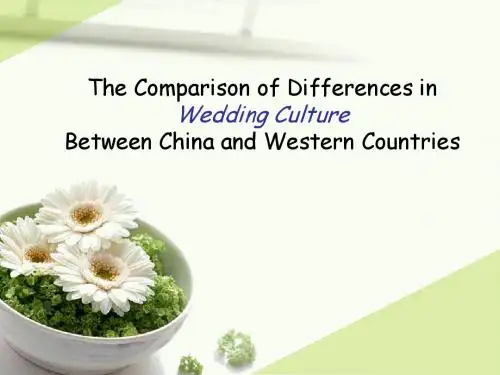
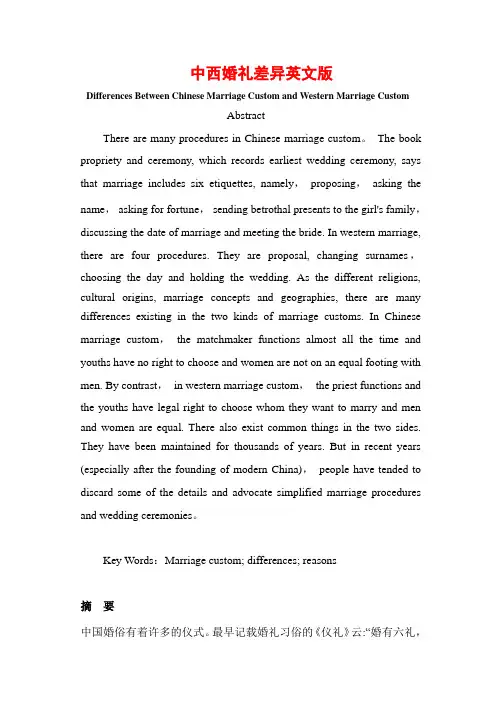
中西婚礼差异英文版Differences Between Chinese Marriage Custom and Western Marriage CustomAbstractThere are many procedures in Chinese marriage custom。
The book propriety and ceremony, which records earliest wedding ceremony, says that marriage includes six etiquettes, namely,proposing,asking the name,asking for fortune,sending betrothal presents to the girl's family,discussing the date of marriage and meeting the bride. In western marriage, there are four procedures. They are proposal, changing surnames,choosing the day and holding the wedding. As the different religions, cultural origins, marriage concepts and geographies, there are many differences existing in the two kinds of marriage customs. In Chinese marriage custom,the matchmaker functions almost all the time and youths have no right to choose and women are not on an equal footing with men. By contrast,in western marriage custom,the priest functions and the youths have legal right to choose whom they want to marry and men and women are equal. There also exist common things in the two sides. They have been maintained for thousands of years. But in recent years (especially after the founding of modern China),people have tended to discard some of the details and advocate simplified marriage procedures and wedding ceremonies。
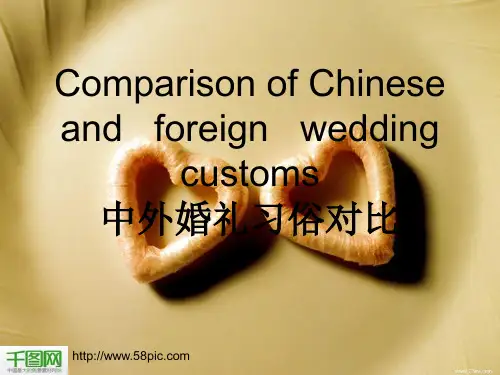
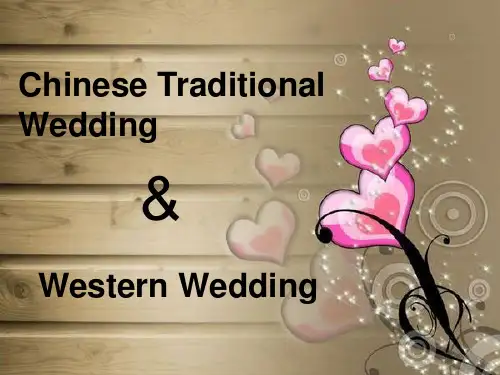

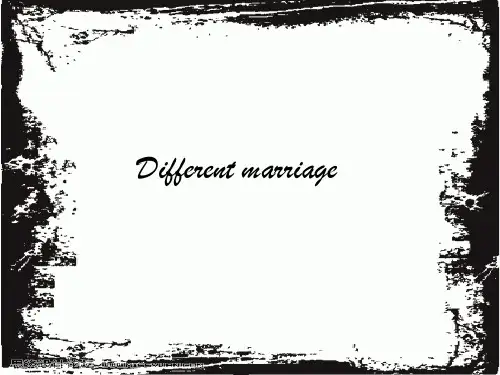
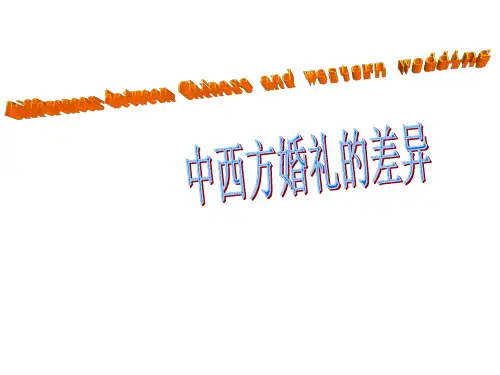
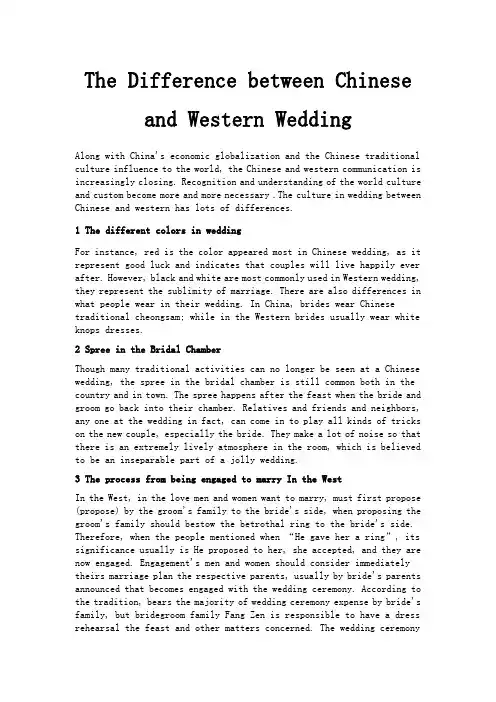
The Difference between Chinese and Western WeddingAlong with China's economic globalization and the Chinese traditional culture influence to the world, the Chinese and western communication is increasingly closing. Recognition and understanding of the world culture and custom become more and more necessary .The culture in wedding between Chinese and western has lots of differences.1 The different colors in weddingFor instance, red is the color appeared most in Chinese wedding, as it represent good luck and indicates that couples will live happily ever after. However, black and white are most commonly used in Western wedding, they represent the sublimity of marriage. There are also differences in what people wear in their wedding. In China, brides wear Chinese traditional cheongsam; while in the Western brides usually wear white knops dresses.2 Spree in the Bridal ChamberThough many traditional activities can no longer be seen at a Chinese wedding, the spree in the bridal chamber is still common both in the country and in town. The spree happens after the feast when the bride and groom go back into their chamber. Relatives and friends and neighbors, any one at the wedding in fact, can come in to play all kinds of tricks on the new couple, especially the bride. They make a lot of noise so that there is an extremely lively atmosphere in the room, which is believed to be an inseparable part of a jolly wedding.3 The process from being engaged to marry In the WestIn the West, in the love men and women want to marry, must first propose (propose) by the groom's family to the bride's side, when proposing the groom's family should bestow the betrothal ring to the bride's side. Therefore, when the people mentioned when “He gave her a ring”, its significance usually is He proposed to her, she accepted, and they are now engaged. Engagement's men and women should consider immediately theirs marriage plan the respective parents, usually by bride's parents announced that becomes engaged with the wedding ceremony. According to the tradition, bears the majority of wedding ceremony expense by bride's family, but bridegroom family Fang Zen is responsible to have a dress rehearsal the feast and other matters concerned. The wedding ceremonystarts previous 1-2 days should officially to have a dress rehearsal, does the goal is causes to participate in wedding ceremony's each people to be familiar with them to want the routine procedure at the wedding ceremony.4 The wedding ceremony in the Western country is a very important situation,In the hold wedding ceremony first several weeks, the relatives and friends will receive the invitation letter. The wedding ceremony is moreover is held in the church in the daytime, if you attain the invitation, then when attends the wedding ceremony the clothing should be official. The female guest puts on the cocktail party formal clothes either the long shirt adds the holiday coat or the woolen sweater; the male guest wants to put on the formal clothes. It is noteworthy that woman puts on the pants is inappropriate, regardless of the pants are any color.5 the wedding flowerAt the westerner wedding ceremony flowers are funded at everywhere, from the church to the hotel, slightly to church in each chair, there is no place does not have the flower's existence. They like the use pink color department the flower, powdery white, the powder is blue, flesh color, the powder is green, and powder purple, light creamy yellow…Moreover they like using the fresh flowers, will not use the artificial flower. Generally marries every time to the new person, fresh flower's amount of use is quite big. Finds at everywhere is the flower, because of each splendid attire attendance woman, no matter its age, can put on a wad flower in the chignon place to show to new people's respect.6 Giving a presentGives a present is the custom which many nationalities altogether have, especially in china then time relatives and friends’ marriage what delivers ]ell We provide some principles for everybody reference: First is posse. Belly the goods which likes for the accepting gifts person, next do not be too expensive, has is again must have the usability.7 The custom of veil and kissWestern female when marriage also has wears veil's custom, at first, the bride wears the veil is young and the chastity symbol, but believes in Catholicism's bride to wear the veil to represent chastely. Therefore, many brides rush to the church holds when the wedding ceremony chooses wear the double-decked veil. After bride's father gives the daughter the bridegroom, by the bridegroom personally opened the veil. Finally, according to the custom, the wedding ceremony finished by new person's kiss announcement. This kisses the rich profound meaning: Through kissing,a person's breath and the partial souls keep another person in vivo, love cause them to combine. However in china people like to choose the red veil and kiss the lover at no others’ place.8 The main character of Chinese weddingChinese wedding ceremonies end with fireworksChinese weddings gather people for a banquet after the ceremony, usually on a restaurant. Western couples invite people to their home.The Chinese bride and groom are usually chosen by their parents; if they disobey their parents' wish, they can be social outcasts, lose their jobs and so on. Marriage in China is thus more of a social contract between families than a binding of love. This is one reason to why out of wedlock relations are so common in China. And it is also a reason to why Chinese girls look for foreigner. Note that children born out of wedlock have no rights in China; no right to go to school, no right to medical care and so on; this is what the 5000 year old culture so proudly call human interestIn shortCultural traditions range from dress to participation. In some cases a groom takes the lead and in others the bride takes the leading role. Wedding ceremonies differ greatly - not just between China and the Western countries - but they differ widely even among the people themselves in any country you choose to look at. Through the study of differences between Chinese and western at the wedding of the cultural I have opened horizon and Learned lots of knowledge.。
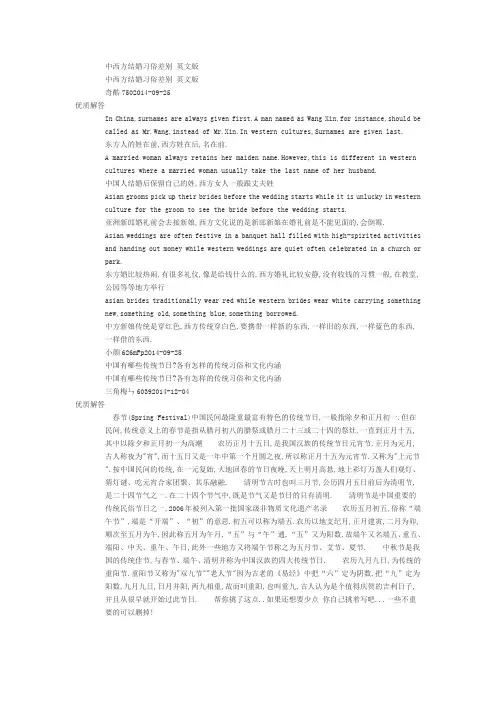
中西方结婚习俗差别英文版中西方结婚习俗差别英文版奇酷7502014-09-25优质解答In China,surnames are always given first.A man named as Wang Xin,for instance,should be called as Mr.Wang,instead of Mr.Xin.In western cultures,Surnames are given last.东方人的姓在前,西方姓在后,名在前.A married woman always retains her maiden name.However,this is different in westerncultures where a married woman usually take the last name of her husband.中国人结婚后保留自己的姓,西方女人一般跟丈夫姓Asian grooms pick up their brides before the wedding starts while it is unlucky in western culture for the groom to see the bride before the wedding starts.亚洲新郎婚礼前会去接新娘,西方文化说的是新郎新娘在婚礼前是不能见面的,会倒霉.Asian weddings are often festive in a banquet hall filled with high-spirited activities and handing out money while western weddings are quiet often celebrated in a church or park.东方婚比较热闹,有很多礼仪,像是给钱什么的,西方婚礼比较安静,没有收钱的习惯一般,在教堂,公园等等地方举行asian brides traditionally wear red while western brides wear white carrying something new,something old,something blue,something borrowed.中方新娘传统是穿红色,西方传统穿白色,要携带一样新的东西,一样旧的东西,一样蓝色的东西,一样借的东西.小颜626mFp2014-09-25中国有哪些传统节日?各有怎样的传统习俗和文化内涵中国有哪些传统节日?各有怎样的传统习俗和文化内涵三角梅ㄣ60392014-12-04优质解答春节(Spring Festival)中国民间最隆重最富有特色的传统节日,一般指除夕和正月初一.但在民间,传统意义上的春节是指从腊月初八的腊祭或腊月二十三或二十四的祭灶,一直到正月十五,其中以除夕和正月初一为高潮农历正月十五日,是我国汉族的传统节日元宵节.正月为元月,古人称夜为"宵",而十五日又是一年中第一个月圆之夜,所以称正月十五为元宵节.又称为"上元节".按中国民间的传统,在一元复始,大地回春的节日夜晚,天上明月高悬,地上彩灯万盏人们观灯、猜灯谜、吃元宵合家团聚、其乐融融. 清明节古时也叫三月节,公历四月五日前后为清明节,是二十四节气之一.在二十四个节气中,既是节气又是节日的只有清明. 清明节是中国重要的传统民俗节日之一,2006年被列入第一批国家级非物质文化遗产名录农历五月初五,俗称“端午节”,端是“开端”、“初”的意思.初五可以称为端五.农历以地支纪月,正月建寅,二月为卯,顺次至五月为午,因此称五月为午月,“五”与“午”通,“五”又为阳数,故端午又名端五、重五、端阳、中天、重午、午日,此外一些地方又将端午节称之为五月节、艾节、夏节. 中秋节是我国的传统佳节,与春节、端午、清明并称为中国汉族的四大传统节日. 农历九月九日,为传统的重阳节.重阳节又称为"双九节""老人节"因为古老的《易经》中把“六”定为阴数,把“九”定为阳数,九月九日,日月并阳,两九相重,故而叫重阳,也叫重九,古人认为是个值得庆贺的吉利日子,并且从很早就开始过此节日. 帮你挑了这点..如果还想要少点你自己挑着写吧...一些不重要的可以删掉!中国的传统节日礼仪习俗有哪些中国的传统节日礼仪习俗有哪些TA002032014-09-28优质解答春节春节代表着新的开始与新的希望,春节是中国民间传统中最为隆重和盛大的节日.历朝历代,无论是达官显贵,还是贩夫走卒,所有的中国人都有把春节看作是喜庆团聚的好日子.春节,古称元旦.据民间习俗,从腊月二十四起到新年正月十五闹元宵止都称春节.现在春节的庆祝活动一般从大年三十(二十九)开始.春节期间,家家户户清扫一新,贴春联、贴年画、守岁、放鞭炮、拜年等活动丰富多彩.扫尘:每年从农历腊月二十三日起到除夕止,我国民间把这段时间叫做“迎春日”,也叫“扫尘日”.扫尘就是年终大扫除,北方称“扫房”,南方叫“掸尘”.每逢春节来临,家家产户都要打扫环境,清洗各种器具,拆洗被褥窗帘,洒扫六闾庭院,掸拂尘垢蛛网,疏浚明渠暗沟,到处洋溢着欢欢喜喜搞卫生、干干净净迎新春的气氛.办年货:一到腊月,人们都要上街采办过年的物品,买年画,准备过年的春联.吃团年饭:团年饭意为一家团圆.腊月的最后一天要全家团聚吃一顿丰富的年饭.凡家中在外地工作或学习的家人都会尽可能赶回家团聚.这顿饭要吃得欢欢乐乐,菜肴吃食也具有吉利的象征意义,如鱼(年年有余)、整鸡(大吉大利)、青菜(清洁平安)、年糕(年年高)等.吃饭时,不要说丧气的、不吉利的话,不能失手打破碗碟杯盏,不要碰翻椅凳,因为这些会被视为不吉利的征兆.守岁:除夕之夜,灯火通明,家人围坐一起畅谈,长辈要将事先准备好的压岁钱分给晚辈,“岁”与“祟”谐音,晚辈得到压岁钱就可以平平安安度过一岁.除夕之夜,在我国北方家家都要包饺子.鞭炮迎新:“爆竹一声除旧,桃符万户更新.”古代燃放鞭炮是为了驱鬼祛邪,而如今则表示节庆欢乐,鞭炮越响,来年家庭财源会越兴旺.拜年:新年伊始,人们走亲访友,登门拜年互致节日祝贺,联络感情.拜年的习俗各地并不相同,但一般初一上午不走亲访友.出去拜年要穿戴整洁.出门遇到熟人、朋友要恭贺新年,说些吉利话,即使是遇见平时与之开惯了玩笑的人也不能随便开玩笑.见到长辈要行拱手礼.走亲访友要携带礼物.过年时,招待宾客的食物有讲究,通常以谐音讨口彩,比如吃柿子苹果,喻意事事平安;吃年糕则意味着年年高升.春节期间,人们还经常走上街头,参加舞狮子、耍龙灯、踩高跷、逛花会等娱乐项目.春节期间也要注意喜庆有度.这一期间热闹的时候比较多,不应为了自己开心而打扰了邻居们休息.春节不仅要拜年,有时候也要恭喜人家喜迁新居.看看新房的格局,参谋一下崭新的家具,如果您是访客,也会有这样的“猎奇”心理.但参观前应该征得主人的同意,等待主人的邀请,而不要主动直接提出参观请求,令主人不好拒绝.如果受到主人邀请参观,也要跟在主人身后,不要自己去打开房间门,尤其是卧室和主卫的门.因为有很多城市都不允许燃放烟花,有的人也没有放鞭炮的喜好,所以过年送礼最好不要送鞭炮.元宵节农历正月十五是一年中第一个月圆之夜,叫元宵节,又称“上元节”或“灯节”.自唐朝开始,民间就有元宵之夜观灯的风俗.现在元宵节有很多节俗活动.吃元宵是元宵节最主要的活动.古时候人们把元宵这种食品叫汤圆、汤团或团子.元宵的形状是圆形,又含着一个“圆”字的同音字,象征着团圆、美满、吉祥、和睦的家庭,所以人们多取其意,这一天要吃元宵.灯会在夜间举行,一般从正月初十开始就行动起来,人人动手,家家户户扎花灯、点花灯,特别是到了元宵节的夜晚时分,更是举烛张灯,结彩为戏,供人观赏,所以元宵节又称“灯节”.在明清时,花灯的样式最为繁多,数不胜数.现在政府、民间都会组织大型灯会.端午节农历五月初五为端午节,又称端阳节、午日节、五月节、艾节、端五、重午、午日、夏节.相传爱国诗人屈原在农历五月初五这天怀抱石头投汨罗江自尽,两岸百姓知道后,纷纷划船打捞他的尸体,并向江中投放粽子,使鱼虾饱食后不吃他的尸体.此传说历代沿袭下来,演变成如今端午节吃粽子、赛龙舟的习俗.节日的习俗礼仪有:挂菖蒲、艾叶:民间特别是农村家庭,门窗上要挂菖蒲、艾叶,用以驱鬼辟邪保平安.虽然这是迷信,但因艾叶、菖蒲具有杀虫、驱寒、消毒之用,故这一习俗一直保持下来,城乡许多家庭都在这一日采集艾叶,以备常年家用.吃大蒜头、喝雄黄酒:端午节,家庭要备一桌丰盛于平日的饭菜,全家共享.这一餐习惯上要吃大蒜头煮肉,喝雄黄酒.大人会在不能喝酒的孩子额头上沾上雄黄,或画一个“王字”,去病消灾.这种习俗在现代城市已逐渐被人遗忘.吃粽子:端午节吃粽是我国民间长久盛行的习俗.早在1300多年前的唐朝,吃粽已经流行.在湖南岳阳、益阳一带,端午还兴吃麻花,当地把它称“油绞”,女婿去丈母娘家拜节,也要提一串麻花.据说,吃麻花也是为了纪念屈原.赛龙舟:当时楚人因合不得贤臣屈原死去,于是有许多人划船追赶拯救,借划龙舟驱散江中之鱼,以免鱼吃掉屈原的尸体.竞渡之习,盛行于吴、越、楚.佩香囊:端午节小孩佩香囊,不但有避邪驱瘟之意,而且有襟头点缀之风.香囊内有朱砂、雄黄、香药,外包以丝布,清香四溢,再以五色丝线弦扣成索,作各种不同形状,结成一串,形形色色,玲珑夺目.中秋节农历八月正好在秋季的中间,古人谓“仲秋”,八月十五又在“仲秋”之中,所以称“中秋”,恰逢此日又与月有关的“中秋节”就有了许多别称:“八月节”、“八月半”、“月节”、“月夕”,继而引申为以圆月为象征的“团圆节”.人们邀请亲朋好友,夜饮玩月,连回娘家的媳妇这天都必须返还夫家.中秋晚上,我国大部分地区有烙“团圆”的习俗,即烙一种象征团圆、类似月亮的小饼子,即“月饼”.饼内包糖、芝麻、桂花和蔬菜等,外压月亮、桂树、兔子等图案.祭月之后,由家中长者将饼按人数分切成块,每人一块,如有人不在家即为其留下一份,表示阖家团圆.重阳节农历九月九日,是我国传统的重阳节,又名重九节、登高节、菊花节、茱萸节.我国古代把九定为阳数,农历九月九日,月日并阳,两阳相重,两九相叠,故名“重阳”,又名“重九”.每到这一天,人们出游登高,赏菊花,饮菊花酒,佩茱萸,吃重阳糕.时至今日,一些地区仍保存着这种风俗.政府还把重阳节定为“敬老节”,向老年人表达敬意之情并帮助他们解决困难等.冬至与腊月冬至是我国的一个重要节气,时间是12月22日或23日.过了冬至,我国大部分地区将进入最寒冷的时期.俗话说:“冬至大如年.”古代,在这一天有祭天、祭祖、拜贺、食百味馄饨等习俗,今天人们也在这一天祭祀先祖.腊月为腊月初八,有吃“腊八粥”的风俗.西方国家的节日习俗与简介分享|2013-04-14 15:29匿名|浏览2127 次西方国家的节日习俗与简介,每个节日介绍100字左右,要不同国家的,每个国家3个左右的节日就好。
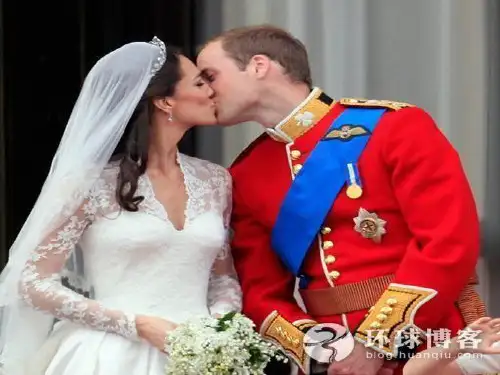
中西方婚姻习俗比较分析英文Another difference lies in the wedding ceremonies and traditions. In China, weddings are usually elaborate and consist of several customs that must be followed. The Chinese wedding ceremony often includes rituals such as tea ceremonies, exchange of wedding vows, and the gifting of red envelopes. These traditions symbolize the respect and blessings from the parents and family. In the United States, weddings are often more casual and less formal. Couples often exchange vows and rings in a simple ceremony, followed by a reception that includes dancing, dinner, and toasts.Additionally, the role of religion in wedding ceremonies varies between the East and the West. In China, traditional wedding ceremonies are often influenced by Confucianism, Taoism, or Buddhism, depending on the region. These religious beliefs are incorporated into the customs and rituals of the wedding. In contrast, Western wedding ceremonies are often conducted in a religious setting, such as a church, with religious elements incorporated into the ceremony based on the couple's faith.In terms of gender roles, there are also differences between the East and the West. In China, traditional gender roles are still prevalent, where men are expected to be the breadwinners and women are expected to take care of the household and children. However, this is gradually evolving with theincreasing empowerment of women and the influence of Western ideals. In Western culture, gender roles are generally less rigid, and both men and women are expected to contribute to the household and share responsibilities.In conclusion, there are significant differences between the marriage customs in the East and the West. In China, marriage is often seen as a union between two families, with a strong emphasis on tradition and fulfilling family expectations. On the other hand, in the Western culture, marriage is primarily viewed as a union based on love and individual choice. Wedding ceremonies, the role of parents, religious influences, and gender roles also vary between the two cultures. Understanding and appreciating these differences can help foster cultural understanding and acceptance.。
中西方婚礼区别和相同之处英语作文Title: Comparative Analysis of Chinese and Western Wedding CustomsIn the vast tapestry of human cultures, weddings stand as celebratory milestones, uniting not just two individuals but also their respective families and traditions. While the essence of weddings across the globe revolves around love, commitment, and the beginning of a new chapter, the customs and rituals differ significantly between Eastern and Western societies, particularly when comparing Chinese and Western weddings. This essay delves into these differences and uncovers the surprising similarities that exist amidst the diversity.**Differences:**1. **Ceremonial Structure:** One of the primary distinctions lies in the structure of the ceremonies. Western weddings typically follow a clear sequence: the wedding ceremony in a church or outdoor setting, followed by a reception. In contrast, traditional Chinese weddings encompass a series of rituals spread over several days,including the proposal with gifts (Guo Da Li), the bridal chamber decoration (An Chuang), and the actual wedding day ceremonies.2. **Symbolism and Rituals:** Each culture imbues its weddings with unique symbolism. Western weddings often feature the exchange of rings as a symbol of eternal love, while Chinese weddings include the tea ceremony, where the couple serves tea to their elders as a sign of respect andto receive blessings.3. **Dress Code:** The attire worn during the ceremonies also differs. Western brides traditionally wear white gowns symbolizing purity, whereas Chinese brides often opt forred dresses, symbolizing luck, prosperity, and happiness.4. **Guest Participation:** Western weddings encourage active guest participation, from the tossing of the bouquet to speeches and dances. Chinese weddings, on the other hand, tend to be more formal, with guests witnessing the rituals rather than actively participating.**Similarities:**Despite these differences, there are fundamental commonalities:1. **Family and Community Involvement:** Both Chinese and Western weddings emphasize the importance of family and community. Families play crucial roles in planning and executing the events, and gatherings serve to strengthen bonds within and between families.2. **Exchange of Vows and Rings:** Although thespecifics vary, both traditions involve the exchange of vows and some form of a token—rings in the West, and sometimes jewelry or other meaningful items in Chinese weddings—to symbolize the commitment being made.3. **Feasting and Celebration:** Celebrations in both cultures culminate in a feast, where guests gather to enjoy food, drinks, and merriment, marking the joyous union with toasts and well wishes.4. **Lasting Commitment:** At the heart of it all, Chinese and Western weddings alike celebrate the love between two people and their decision to commit to each other for life.In conclusion, while Chinese and Western weddingsexhibit rich and diverse customs, they share a universal theme of love, unity, and the celebration of new beginnings. These ceremonies, though differing in details, ultimately serve as testaments to the enduring human desire for connection and the creation of shared memories.---**中西方婚礼习俗的比较分析**在全球文化的广阔画卷中,婚礼作为庆祝的里程碑,不仅联结了两个人,也融合了各自家庭与传统。
中西婚礼差异英文版Differences Between Chinese Marriage Custom and Western Marriage CustomAbstractThere are many procedures in Chinese marriage custom. The book propriety and ceremony, which records earliest wedding ceremony, says that marriage includes six etiquettes, namely, proposing, asking the name, asking for fortune, sending betrothal presents to the girl's family, discussing the date of marriage and meeting the bride. In western marriage, there are four procedures. They are proposal, changing surnames, choosing the day and holding the wedding. As the different religions, cultural origins, marriage concepts and geographies, there are many differences existing in the two kinds of marriage customs. In Chinese marriage custom, the matchmaker functions almost all the time and youths have no right to choose and women are not on an equal footing with men. By contrast, in western marriage custom, the priest functions and the youths have legal right to choose whom they want to marry and men and women are equal. There also exist common things in the two sides. They have been maintained for thousands of years. But in recent years (especially after the founding of modern China), people have tended to discard some of the details and advocate simplifiedmarriage procedures and wedding ceremonies.Key Words:Marriage custom; differences; reasons摘要中国婚俗有着许多的仪式。